Hermaphrodite
A hermaphrodite (/hərˈmæfrəˌdaɪt/) is a sexually reproducing organism that produces both male and female gametes.[1] Animal species in which individuals are of different sexes, either male or female but not both, are gonochoric, which is the opposite of hermaphroditic.[2]
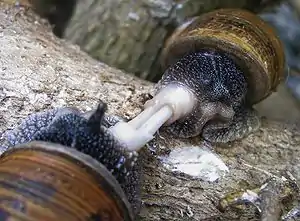
The individuals of many taxonomic groups of animals, primarily invertebrates, are hermaphrodites, capable of producing viable gametes of both sexes. In the great majority of tunicates, mollusks, and earthworms, hermaphroditism is a normal condition, enabling a form of sexual reproduction in which either partner can act as the female or male. Hermaphroditism is also found in some fish species, but is rare or absent in other vertebrate groups. Most hermaphroditic species exhibit some degree of self-fertilization. The distribution of self-fertilization rates among animals is similar to that of plants, suggesting that similar pressures are operating to direct the evolution of selfing in animals and plants.[3]
A rough estimate of the number of hermaphroditic animal species is 65,000, about 5% of all animal species, or 33% excluding insects. Insects are almost exclusively gonochoric, and no definitive cases of hermaphroditism have been demonstrated in this group.[4] There are no hermaphroditic species among mammals[5] or birds.[6]
About 94% of flowering plant species are either hermaphroditic (all flowers produce both male and female gametes) or monoecious, where both male and female flowers occur on the same plant. There are also mixed breeding systems, in both plants and animals, where hermaphrodite individuals coexist with males (called androdioecy) or with females (called gynodioecy), or all three exist in the same species (called trioecy). Sometimes, both male and hermaphrodite flowers occur on the same plant (andromonoecy) or both female and hermaphrodite flowers occur on the same plant (gynomonoecy).
Hermaphrodism is not to be confused with intersexuality, which is a separate and unrelated phenomenon. The usage of the term hermaphrodite to describe intersex people is considered to be offensive,[7] and it is also scientifically incorrect as hermaphrodism does not exist in humans.[8][9]
Etymology
The term hermaphrodite derives from the Latin: hermaphroditus, from Ancient Greek: ἑρμαφρόδιτος, romanized: hermaphroditos,[10] which derives from Hermaphroditus (Ἑρμαφρόδιτος), the son of Hermes and Aphrodite in Greek mythology. According to Ovid, he fused with the nymph Salmacis resulting in one individual possessing physical traits of male and female sexes.[11] According to the earlier Diodorus Siculus, he was born with a physical body combining male and female sexes.[12] The word hermaphrodite entered the English lexicon as early as the late fourteenth century.[13]
Animals
Sequential hermaphrodites

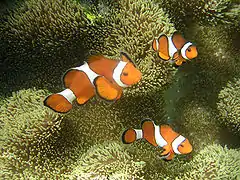

Sequential hermaphrodites (dichogamy) occur in species in which the individual first develops as one sex, but can later change into the opposite sex.[14] This contrasts with simultaneous hermaphrodites, in which an individual possesses fully functional male and female genitalia. Sequential hermaphroditism is common in fish (particularly teleost fish) and many gastropods (such as the common slipper shell). Sequential hermaphrodites can only change sex once.[15] Sequential hermaphroditism can best be understood in terms of behavioral ecology and evolutionary life history theory, as described in the size-advantage mode[16] first proposed by Michael T. Ghiselin[17] which states that if an individual of a certain sex could significantly increase its reproductive success after reaching a certain size, it would be to their advantage to switch to that sex.
Sequential hermaphrodites can be divided into three broad categories:
- Protandry: Where an organism develops as a male, and then changes sex to a female.[14]
- Example: The clownfish (genus Amphiprion) are colorful reef fish found living in symbiosis with sea anemones. Generally one anemone contains a 'harem', consisting of a large female, a smaller reproductive male, and even smaller non-reproductive males. If the female is removed, the reproductive male will change sex and the largest of the non-reproductive males will mature and become reproductive. It has been shown that fishing pressure can change when the switch from male to female occurs, since fishermen usually prefer to catch the larger fish. The populations are generally changing sex at a smaller size, due to natural selection.
- Protogyny: Where the organism develops as a female, and then changes sex to a male.[14]
- Example: Wrasses (Family Labridae) are a group of reef fish in which protogyny is common. Wrasses also have an uncommon life history strategy, which is termed diandry (literally, two males). In these species, two male morphs exists: an initial phase male and a terminal phase male. Initial phase males do not look like males and spawn in groups with females. They are not territorial. They are, perhaps, female mimics (which is why they are found swimming in group with females). Terminal phase males are territorial and have a distinctively bright coloration.[18] Individuals are born as males or females, but if they are born males, they are not born as terminal phase males. Females and initial phase males can become terminal phase males. Usually, the most dominant female or initial phase male replaces any terminal phase male when those males die or abandon the group.
- Bidirectional sex changers: Where an organism has female and male reproductive organs, but may act either as a female or as a male during different stages in life.[14]
- Example: Lythrypnus dalli (Family Lythrypnus) are a group of coral reef fish in which bidirectional sex change occurs. Once a social hierarchy is established a fish changes sex according to its social status, regardless of the initial sex, based on a simple principle: if the fish expresses subordinate behavior then it changes its sex to female, and if the fish expresses dominant or non-dominant superior behavior then it changes its sex to male.[19]
Dichogamy can have both conservation-related implications for humans, as mentioned above, as well as economic implications. For instance, groupers are favoured fish for eating in many Asian countries and are often aquacultured. Since the adults take several years to change from female to male, the broodstock are extremely valuable individuals.
Simultaneous hermaphrodites
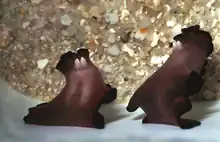

Simultaneous hermaphrodites (or homogamous hermaphrodites) are individuals in which both male and female sexual organs are present and functional at the same time.[14] Self-fertilization often occurs.
- Pulmonate land snails and land slugs are perhaps the best-known kinds of simultaneous hermaphrodites, and are the most widespread of terrestrial animals possessing this sexual polymorphism. Sexual material is exchanged between both animals via spermatophores, and is then stored in the spermatheca. After exchange of spermatozoa, both animals will lay fertilized eggs after a period of gestation. The eggs will proceed to hatch after a development period. Snails typically reproduce from early spring through late autumn.[20]
- Banana slugs are an example of a hermaphroditic gastropod. Mating with a partner is more desirable biologically than self-fertilization, as the genetic material of the resultant offspring is varied, but if mating with a partner is not possible, self-fertilization is practiced. The male sexual organ of an adult banana slug is quite large in proportion to its size, as well as compared to the female organ. It is possible for banana slugs, while mating, to become stuck together. If a substantial amount of wiggling fails to separate them, the male organ will be bitten off (using the slug's radula), see apophallation. If a banana slug has lost its male sexual organ, it can still mate as a female, making hermaphroditism a valuable adaptation.[21]
- The species of colourful sea slugs Goniobranchus reticulatus is hermaphroditic, with both male and female organs active at the same time during copulation. After mating, the external portion of the penis detaches, but is able to regrow within 24 hours.[22][23]
- Earthworms are another example of a simultaneous hermaphrodite. Although they possess ovaries and testes, they have a protective mechanism against self-fertilization. Sexual reproduction occurs when two worms meet and exchange gametes, copulating on damp nights during warm seasons.
- The free-living hermaphroditic nematode Caenorhabditis elegans reproduces primarily by self-fertilization, but infrequent out-crossing events occur at a rate of approximately 1%.[24]
- Hamlets do not practice self-fertilization, but a pair will mate multiple times over several nights, taking turns between which one acts as the male and which acts as the female.[25]
- The mangrove killifish (Kryptolebias marmoratus) are simultaneous hermaphrodites, producing both eggs and sperm and routinely reproducing by self-fertilization. Each individual normally fertilizes itself when an egg and sperm produced by an internal organ unite inside the fish's body.[26] This species is also regarded as the only known vertebrate species that can reproduce by self fertilization.[27]
Pseudohermaphroditism
When spotted hyenas were first scientifically observed by explorers, they were thought to be hermaphrodites. Early observations of spotted hyenas in the wild led researchers to believe that all spotted hyenas, male and female, were born with what appeared to be a penis. The apparent penis in female spotted hyenas is in fact an enlarged clitoris, which contains an external birth canal.[28][29] It can be difficult to determine the sex of wild spotted hyenas until sexual maturity, when they may become pregnant. When a female spotted hyena gives birth, they pass the cub through the cervix internally, but then pass it out through the elongated clitoris.[30]
Plants
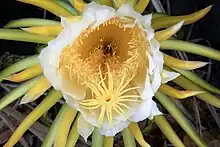
The term hermaphrodite is used in botany to describe, for example, a perfect flower that has both staminate (male, pollen-producing) and carpellate (female, ovule-producing) parts. The overwhelming majority of flowering plant species are hermaphrodite.[31]
Monoecy
Flowering plant species with separate, imperfect, male and female flowers on the same individual are called monoecious. Monoecy only occurs in about 7% of flowering plant species.[32] Monoecious plants are often referred to as hermaphroditic because they produce both male and female gametes. However, the individual flowers are not hermaphroditic if they only produce gametes of one sex.[33] 65% of gymnosperm species are dioecious, but conifers are almost all monoecious.[34] Some plants can change their sex throughout their lifetime, a phenomenon called Sequential hermaphroditism.
Andromonecy
In andromonecious species, the plants produce perfect (hermaphrodite) flowers and separate fertile male flowers that are sterile as female.[35][36] Andromonecy occurs in about 4000 species of flowering plants (2% of flowering plants).[37]
Gynomonoecy
In gynomonoecious species, the plants produce hermaphrodite flowers and separate male-sterile pistillate flowers.[35] One example is the meadow saxifrage, Saxifraga granulata.[38] Charles Darwin gave several other examples in his 1877 book "The Different Forms of Flowers on Plants of the Same Species".[39]
About 57% of moss species and 68% of liverworts are unisexual, meaning that their gametophytes produce either male or female gametes, but not both.[40]: 377
Sequential hermaphroditism is common in bryophytes and some vascular plants.
Use regarding humans
| Intersex topics |
|---|
 |
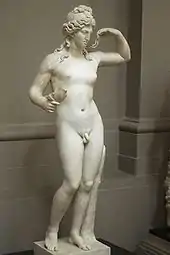

.jpg.webp)
Historically, the term hermaphrodite was used in law to refer to people whose sex was in doubt. The 12th-century Decretum Gratiani states that "Whether an hermaphrodite may witness a testament, depends on which sex prevails" ("Hermafroditus an ad testamentum adhiberi possit, qualitas sexus incalescentis ostendit.").[43][44].
Alexander ab Alexandro (1461–1523) stated, using the term hermaphrodite, that the people who bore the sexes of both man and woman were regarded by the Athenians and the Romans as monsters, and thrown into the sea at Athens and into the Tiber at Rome.[45] Similarly, the 17th-century English jurist and judge Edward Coke (Lord Coke), wrote in his Institutes of the Lawes of England on laws of succession stating, "Every heire is either a male, a female, or an hermaphrodite, that is both male and female. And an hermaphrodite (which is also called Androgynus) shall be heire, either as male or female, according to that kind of sexe which doth prevaile."[46][47]
During the Victorian era, medical authors attempted to ascertain whether or not humans could be hermaphrodites, adopting a precise biological definition to the term.[48] From that period until the early 21st century, intersex individuals were termed true hermaphrodites if their gonadal tissue contained both testicular and ovarian tissue, or pseudohermaphrodites if their external appearance (phenotype) differed from sex expected from internal gonads. This language has fallen out of favor due to misconceptions and pejorative connotations associated with the terms,[49] and also a shift to nomenclature based on genetics.
The term intersex describes a wide variety of combinations of what are considered male and female biological characteristics. Intersex biology may include, for example, ambiguous-looking external genitalia, karyotypes that include mixed XX and XY chromosome pairs (46XX/46XY, 46XX/47XXY or 45X/XY mosaic). Clinically, medicine currently describes intersex people as having disorders of sex development,[50] a term that has been vigorously challenged.[51] This is particularly significant because of the relationship between medical terminology and medical intervention.[52]
Intersex civil society organizations, and many human rights institutions,[53][54] have criticized medical interventions designed to make intersex bodies more typically male or female.
In some cases, intersex traits are caused by unusual levels of sex hormones, which may be the result of an atypical set of sex chromosomes. One common cause of intersex traits is the crossing over of the testis-determining factor (SRY) from the Y chromosome to the X chromosome during meiosis. The SRY is then activated in only certain areas, causing development of testes in some areas by beginning a series of events starting with the upregulation of the transcription factor (SOX9), and in other areas not being active (causing the growth of ovarian tissues). Thus, testicular and ovarian tissues will both be present in the same individual.[55]
Fetuses before sexual differentiation are sometimes described as female by doctors explaining the process.[56] This is not technically true. Before this stage, humans are simply undifferentiated and possess a paramesonephric duct, a mesonephric duct, and a genital tubercle.
Evolution
The evolution of anisogamy may have contributed to the evolution of simultaneous hermaphroditism and sequential hermaphroditism,[6] but it remains unclear if the evolution of anisogamy first led to hermaphroditism or gonochorism.[57]: 213 It is possible that hermaphroditism evolved from gonochorism, or vice versa. Most studies on its evolution focus on plants, and its evolution in animals is unclear as of December 2017.[58]
Simultaneous hermaphroditism that exclusively reproduces through self-fertilization has evolved many times in plants and animals, but it might not last long evolutionarily.[59]: 14
In animals
Joan Roughgarden and Priya Iyer argued that the last common ancestor for animals was hermaphroditic and that transitions from hermaphroditism to gonochorism were more numerous than the reverse. However, their argument was based on paraphyletic Spiralia, assignments of sexual modes for the phylum level than the species level, and methods exclusively based on maximum parsimony.[58]
Hermaphroditism is polyphyletic in invertebrates where it evolved from gonochorism[1]: 97 and gonochorism is also ancestral to hermaphroditic fishes.[60] According to Nelson Çabej simultaneous hermaphroditism in animals most likely evolved due to a limited number of mating partners.[61]
In plants
It is widely accepted that the first vascular plants were outcrossing hermaphrodites.[62] In flowering plants, hermaphroditism is ancestral to dioecy.[63]
Hermaphroditism in plants may promote self fertilization in pioneer populations.[64] However, plants have evolved multiple different mechanisms to avoid self-fertilization in hermaphrodites, including sequential hermaphroditism, molecular recognition systems and mechanical or morphological mechanisms such as heterostyly.[65]: 73, 74
See also
References
- Avise JC (2011-03-18). Hermaphroditism: A Primer on the Biology, Ecology, and Evolution of Dual Sexuality. Columbia University Press. pp. 1–7. ISBN 978-0-231-52715-6.
- Holub AM, Shackelford TK (2020). "Gonochorism". In Vonk J, Shackelford TK (eds.). Encyclopedia of Animal Cognition and Behavior (PDF). Cham: Springer International Publishing. pp. 1–3. doi:10.1007/978-3-319-47829-6_305-1. ISBN 978-3-319-47829-6. S2CID 240938739.
- Jarne P, Auld JR (September 2006). "Animals mix it up too: the distribution of self-fertilization among hermaphroditic animals". Evolution; International Journal of Organic Evolution. 60 (9): 1816–24. doi:10.1554/06-246.1. PMID 17089966. S2CID 23849389.
- Royer, M (1975). "Hermaphroditism in Insects. Studies on Icerya purchasi". In Reinboth, R (ed.). Intersexuality in the Animal Kingdom. Berlin, Heidelberg: Springer. pp. 135–145. doi:10.1007/978-3-642-66069-6_14. ISBN 978-3-642-66071-9.
- Gorshkov V (2012-12-06). Physical and Biological Bases of Life Stability: Man, Biota, Environment. Springer Science & Business Media. ISBN 978-3-642-85001-1.
- Schärer L (February 2017). "The varied ways of being male and female". Molecular Reproduction and Development. 84 (2): 94–104. doi:10.1002/mrd.22775. PMID 28032683.
Of note, the otherwise well-studied insects, birds, and mammals are strikingly absent here—with not a single species among these groups showing hermaphroditism (for details on a supposedly hermaphroditic scale insect, however, see Gardner and Ross, 2011).
- Herndon A. "Getting Rid of "Hermaphroditism" Once and For All". Intersex Society of North America. Archived from the original on 27 September 2011. Retrieved 2 October 2011.
- Rosenfield KA (2018), "Hermaphrodite", in Vonk J, Shackelford T (eds.), Encyclopedia of Animal Cognition and Behavior, Cham: Springer International Publishing, pp. 1–2, doi:10.1007/978-3-319-47829-6_329-1, ISBN 978-3-319-47829-6
- Mills A (2018-01-01). Biology of Sex. University of Toronto Press. p. 309. ISBN 978-1-4875-9337-7.
- "Definition of hermaphroditus". Numen: The Latin Lexicon. Archived from the original on 6 November 2014. Retrieved 19 July 2013.
- Ovid, Metamorphoses, Book IV: The story of Hermaphroditus and Salmacis.
- "LacusCurtius • Diodorus Siculus — Book IV Chapters 1‑7". penelope.uchicago.edu.
- "Online Etymology Dictionary". Archived from the original on 5 November 2013. Retrieved 3 June 2012.
- Barrows EM (2001). Animal behavior desk reference: a dictionary of animal behavior, ecology, and evolution (2nd ed.). Boca Raton, Fla: CRC Press. p. 317. ISBN 978-0-8493-2005-7. OCLC 299866547.
- Pandian TJ (2 September 2011). Sex Determination in Fish. CRC Press. ISBN 9781439879191. Archived from the original on 7 November 2017 – via Google Books.
- Warner RR (June 1988). "Sex change and the size-advantage model". Trends in Ecology & Evolution. 3 (6): 133–6. doi:10.1016/0169-5347(88)90176-0. PMID 21227182.
- Ghiselin MT (June 1969). "The evolution of hermaphroditism among animals". The Quarterly Review of Biology. 44 (2): 189–208. doi:10.1086/406066. PMID 4901396. S2CID 38139187.
- Bagemihl, Bruce (1999). Biological exuberance : animal homosexuality and natural diversity (2nd ed.). New York: St. Martin's Press. ISBN 978-0312253776.
- Rodgers EW, Early RL, Grober MA (2007). "Social status determines sexual phenotype in the bi-directional sex changing bluebanded goby Lythrypnus dalli". J Fish Biol. 70 (6): 1660–1668. doi:10.1111/j.1095-8649.2007.01427.x.
- Janssen R, Baur B (July 2015). "Seasonal effects on egg production and level of paternity in a natural population of a simultaneous hermaphrodite snail". Ecology and Evolution. 5 (14): 2916–28. doi:10.1002/ece3.1560. PMC 4541995. PMID 26306176.
- Leonard JL, Pearse JS, Harper AB (2002). "Comparative reproductive biology of Ariolimax californicus and A. dolichophallus (Gastropoda; Stylommiatophora)". Invertebrate Reproduction & Development. 41 (1–3): 83–93. doi:10.1080/07924259.2002.9652738. S2CID 83829239.
- Morelle R (12 February 2013). "Sea slug's 'disposable penis' surprises". BBC News.
- Sekizawa A, Seki S, Tokuzato M, Shiga S, Nakashima Y (April 2013). "Disposable penis and its replenishment in a simultaneous hermaphrodite". Biology Letters. 9 (2): 20121150. doi:10.1098/rsbl.2012.1150. PMC 3639767. PMID 23407499.
- Barrière A, Félix MA (July 2005). "High local genetic diversity and low outcrossing rate in Caenorhabditis elegans natural populations". Current Biology. 15 (13): 1176–84. arXiv:q-bio/0508003. Bibcode:2005q.bio.....8003B. doi:10.1016/j.cub.2005.06.022. PMID 16005289. S2CID 2229622.
- Russell PJ, Hertz PE, McMillan B (2016-01-01). "Animal Reproduction". Biology: The Dynamic Science. Cengage Learning. p. 1151. ISBN 978-1-305-85610-3.
- Sakakura, Y; Soyano, K; Noakes, DLG; Hagiwara, A (2006). "Gonadal morphology in the self-fertilizing mangrove killifish, Kryptolebias marmoratus". Ichthyological Research. 53 (4): 427–430. doi:10.1007/s10228-006-0362-2. hdl:10069/35713. S2CID 9474211.
- Kanamori A, Yamamura A, Koshiba S, Lee JS, Orlando EF, Hori H (October 2006). "Methyltestosterone efficiently induces male development in the self-fertilizing hermaphrodite fish, Kryptolebias marmoratus". Genesis. 44 (10): 495–503. doi:10.1002/dvg.20240. PMID 17029221. S2CID 13639701.
- "The Painful Realities of Hyena Sex". Live Science. 26 April 2006. Archived from the original on 2012-11-19.
- "Hyena Graphic". EurekAlert!. Archived from the original on 2011-03-10. Retrieved 2011-03-20.
- "Hermaphrodite Hyenas?". Archived from the original on 2010-11-23. Retrieved 2011-03-19.
- Soni, N. K. (2010-04-01). Fundamentals of Botany. Tata McGraw-Hill Education. p. 87. ISBN 978-0-07-068177-4.
- Molnar S (17 February 2004). "Plant Reproductive Systems". Evolution and the Origins of Life. Geocities.com. Archived from the original on 2009-10-22. Retrieved 12 September 2009.
- Glover, Beverley (February 2014). Understanding Flowers and Flowering Second Edition. Oxford University Press. pp. 138–139. ISBN 978-0-19-966159-6.
- Walas Ł, Mandryk W, Thomas PA, Tyrała-Wierucka Ż, Iszkuło G (2018). "Sexual systems in gymnosperms: A review" (PDF). Basic and Applied Ecology. 31: 1–9. doi:10.1016/j.baae.2018.05.009. S2CID 90740232.
- Fusco G, Minelli A (2019-10-10). The Biology of Reproduction. Cambridge University Press. pp. 111–113. ISBN 978-1-108-49985-9. Archived from the original on 1 April 2021. Retrieved 29 March 2021.
- Kouonon LC, Jacquemart AL, Bi AI, Bertin P, Baudoin JP, Dje Y (November 2009). "Reproductive biology of the andromonoecious Cucumis melo subsp. agrestis (Cucurbitaceae)". Annals of Botany. 104 (6): 1129–39. doi:10.1093/aob/mcp196. PMC 2766191. PMID 19671577.
- Vallejo-Marín M, Rausher MD (February 2007). "The role of male flowers in andromonoecious species: energetic costs and siring success in Solanum carolinense L". Evolution; International Journal of Organic Evolution. 61 (2): 404–12. doi:10.1111/j.1558-5646.2007.00031.x. PMID 17348949. S2CID 781464.
- Stevens, D.P.; Richards, A.J. (1985). "Gynodioecy in Saxifraga granulata L.". Plant Systematics and Evolution. 151: 43–54. doi:10.1007/BF02418018. S2CID 21632274.
- Darwin, Charles (1877). The different forms of flowers on plants of the same species. London: John Murray.
- Shaw, A.J. (2000). "12". In Shaw, A.J.; Goffinet, B. (eds.). Population ecology, population genetics, and microevolution. pp. 369–402. ISBN 978-0-521-66794-4.
{{cite book}}:|work=ignored (help) - "LAKAPATI: The "Transgender" Tagalog Deity? Not so fast…". THE ASWANG PROJECT. 29 November 2018. Retrieved 2019-07-03.
- Schultheiss, Herrmann & Jonas 2006, p. 358.
- Decretum Gratiani, C. 4, q. 2 et 3, c. 3
- "Decretum Gratiani (Kirchenrechtssammlung)". Bayerische StaatsBibliothek (Bavarian State Library). February 5, 2009. Archived from the original on December 20, 2016.
- chevalier de Jaucourt, Louis (1765). "Hermaphrodite". Encyclopedia of Diderot & d'Alembert. 8: 165–167. Retrieved 13 April 2023.
- E Coke, The First Part of the Institutes of the Laws of England, Institutes 8.a. (1st Am. Ed. 1812).
- Greenberg J (1999). "Defining Male and Female: Intersexuality and the Collision Between Law and Biology". Arizona Law Review. 41: 277–278. SSRN 896307.
- Reis E (2009). Bodies in Doubt: an American History of Intersex. Baltimore: Johns Hopkins University Press. pp. 55–81. ISBN 978-0-8018-9155-7.
- Dreger AD, Chase C, Sousa A, Gruppuso PA, Frader J (August 2005). "Changing the nomenclature/taxonomy for intersex: a scientific and clinical rationale" (PDF). Journal of Pediatric Endocrinology & Metabolism. 18 (8): 729–33. doi:10.1515/JPEM.2005.18.8.729. PMID 16200837. S2CID 39459050. Archived from the original (PDF) on 20 December 2016. Retrieved 27 July 2016.
- Georgiann D (2011). McGann PJ, Hutson DJ (eds.). "DSD is a Perfectly Fine Term": Reasserting Medical Authority through a Shift in Intersex Terminology". Sociology of Diagnosis (Advances in Medical Sociology). Advances in Medical Sociology. 12: 155–182. doi:10.1108/S1057-6290(2011)0000012012. ISBN 978-0-85724-575-5.
- Holmes M (2011). "The Intersex Enchiridion: Naming and Knowledge in the Clinic". Somatechnics. 1 (2): 87–114. doi:10.3366/soma.2011.0026.
- Androgen Insensitivity Support Syndrome Support Group Australia, Intersex Trust Aotearoa New Zealand, Organisation Intersex International Australia, Black E, Bond K, Briffa T, Carpenter M, Morgan, Cody C, David A, Driver B, Hannaford C, Harlow E, Hart B, Hart P, Leckey D, Lum S, Mitchell MB, Nyhuis E, O'Callaghan B, Perrin S, Smith C, Williams T, Yang I, Yovanovic (March 2017), Darlington Statement, archived from the original on 2017-03-22, retrieved March 21, 2017
- UN Committee against Torture; UN Committee on the Rights of the Child; UN Committee on the Rights of People with Disabilities; UN Subcommittee on Prevention of Torture and other Cruel, Inhuman or Degrading Treatment or Punishment; Juan Méndez, Special Rapporteur on torture and other cruel, inhuman, or degrading treatment or punishment; Dainius Pῡras, Special Rapporteur on the right of everyone to the enjoyment of the highest attainable standard of physical and mental health; Dubravka Šimonoviæ, Special Rapporteur on violence against women, its causes and consequences; Marta Santos Pais, Special Representative of the UN Secretary-General on Violence against Children; African Commission on Human and Peoples' Rights; Council of Europe Commissioner for Human Rights; Inter-American Commission on Human Rights (October 24, 2016), "Intersex Awareness Day – Wednesday 26 October. End violence and harmful medical practices on intersex children and adults, UN and regional experts urge", Office of the High Commissioner for Human Rights, archived from the original on November 21, 2016
{{citation}}: CS1 maint: multiple names: authors list (link) - Council of Europe; Commissioner for Human Rights (April 2015), Human rights and intersex people, Issue Paper, archived from the original on 2016-01-06, retrieved 2018-06-10
- Margarit E, Coll MD, Oliva R, Gómez D, Soler A, Ballesta F (January 2000). "SRY gene transferred to the long arm of the X chromosome in a Y-positive XX true hermaphrodite". American Journal of Medical Genetics. 90 (1): 25–8. doi:10.1002/(SICI)1096-8628(20000103)90:1<25::AID-AJMG5>3.0.CO;2-5. PMID 10602113.
- Leyner M, Goldberg B (2005). Why Do Men Have Nipples?: Hundreds of Questions You'd Only Ask a Doctor After Your Third Martini. New York: Three Rivers Press. ISBN 978-1-4000-8231-5. OCLC 57722472.
- Kliman, Richard (2016). Encyclopedia of Evolutionary Biology. Vol. 2. Academic Press. pp. 212–224. ISBN 978-0-12-800426-5. Archived from the original on 2021-05-06. Retrieved 2021-09-29.
{{cite book}}: CS1 maint: bot: original URL status unknown (link) - Sasson DA, Ryan JF (December 2017). "A reconstruction of sexual modes throughout animal evolution". BMC Evolutionary Biology. 17 (1): 242. doi:10.1186/s12862-017-1071-3. PMC 5717846. PMID 29207942.
- Leonard JL (2019-05-21). Transitions Between Sexual Systems: Understanding the Mechanisms of, and Pathways Between, Dioecy, Hermaphroditism and Other Sexual Systems. Springer. ISBN 978-3-319-94139-4.
- Erisman BE, Petersen CW, Hastings PA, Warner RR (October 2013). "Phylogenetic perspectives on the evolution of functional hermaphroditism in teleost fishes". Integrative and Comparative Biology. 53 (4): 736–54. doi:10.1093/icb/ict077. PMID 23817661.
- Cabej, Nelson R. (2013-04-01). Building the Most Complex Structure on Earth: An Epigenetic Narrative of Development and Evolution of Animals. Newnes. p. 101. ISBN 978-0-12-401729-0.
- Orton, Thomas J. (2019-11-21). Horticultural Plant Breeding. Academic Press. p. 176. ISBN 978-0-12-815570-7.
- Núñez-Farfán, Juan; Valverde, Pedro Luis (2020-07-30). Evolutionary Ecology of Plant-Herbivore Interaction. Springer Nature. p. 177. ISBN 978-3-030-46012-9.
- Burns, Kevin C. (2019-05-16). Evolution in Isolation: The Search for an Island Syndrome in Plants. Cambridge University Press. pp. 21–22. ISBN 978-1-108-42201-7.
- Judd, Walter S.; Campbell, Christopher S.; Kellogg, Elizabeth A.; Stevens, Peter F.; Donoghue, Michael J. (2002). Plant systematics, a phylogenetic approach (2 ed.). Sunderland MA, US: Sinauer Associates Inc. ISBN 0-87893-403-0.
Further reading
- "Bony Fishes: Reproduction". SeaWorld/Busch Gardens Animal Infobooks. Busch Entertainment Corporation. 2009. Archived from the original on 25 July 2011. Retrieved 12 September 2009.
- Discovery Health Channel, (2007) "I Am My Own Twin"
- Kim KR, Kwon Y, Joung JY, Kim KS, Ayala AG, Ro JY (October 2002). "True hermaphroditism and mixed gonadal dysgenesis in young children: a clinicopathologic study of 10 cases". Modern Pathology. 15 (10): 1013–9. doi:10.1097/01.MP.0000027623.23885.0D. OCLC 357415945. PMID 12379746.
- Randall JE (2005). Reef and Shore Fishes of the South Pacific: New Caledonia to Tahiti and the Pitcairn Islands. Honolulu, Hawaii: University of Hawaii Press. pp. 346, 387. ISBN 978-0-8248-2698-7. OCLC 52152732.
- Chase C (1998). "Affronting Reason". In Atkins D (ed.). Looking Queer: Body Image and Identity in Lesbian, Bisexual, Gay, and Transgender Communities. New York: Haworth Press. pp. 205–219. ISBN 978-1-56023-931-4. OCLC 38519315.
- Fausto-Sterling A (12 March 1993). "How Many Sexes Are There?". The New York Times. New York. p. Op–Ed., reprinted in: Harwood S, ed. (1996). Business As Ethical and Business As Usual: Text, Readings, and Cases. Belmont, CA: Wadsworth Pub. pp. 168–170. ISBN 978-0-534-54251-1. OCLC 141382073.
- Grumbach MM, Conte FA (1998). "Disorders of sex differentiation". In Williams RH, Wilson JD (eds.). Williams Textbook of Endocrinology. Philadelphia: Saunders. pp. 1303–1425. ISBN 978-0-7216-6152-0. OCLC 35364729.
- Schultheiss D, Herrmann TR, Jonas U (March 2006). "Early photo-illustration of a hermaphrodite by the French photographer and artist Nadar in 1860". The Journal of Sexual Medicine. 3 (2): 355–60. doi:10.1111/j.1743-6109.2005.00157.x. PMID 16490032. (subscription required)